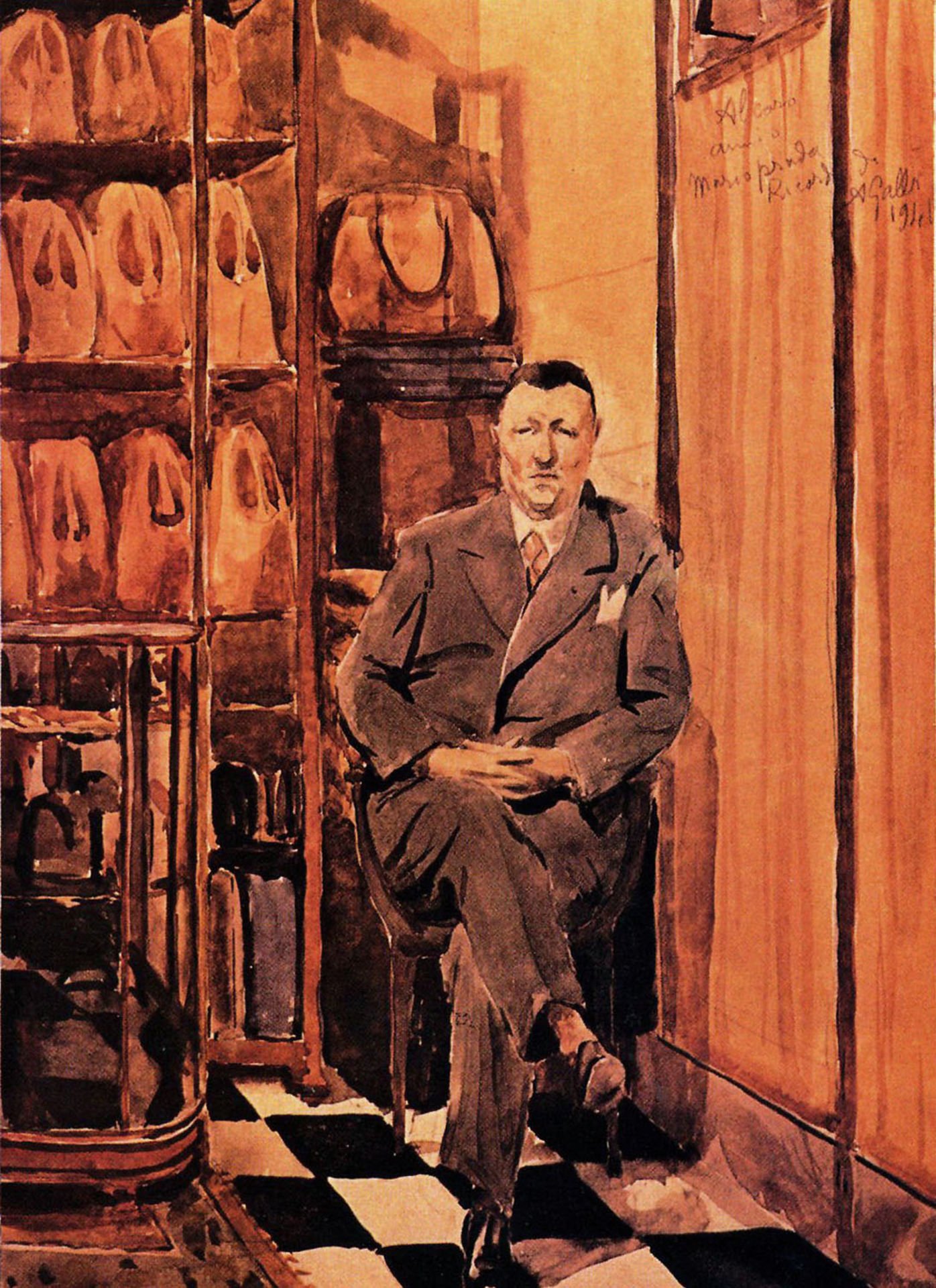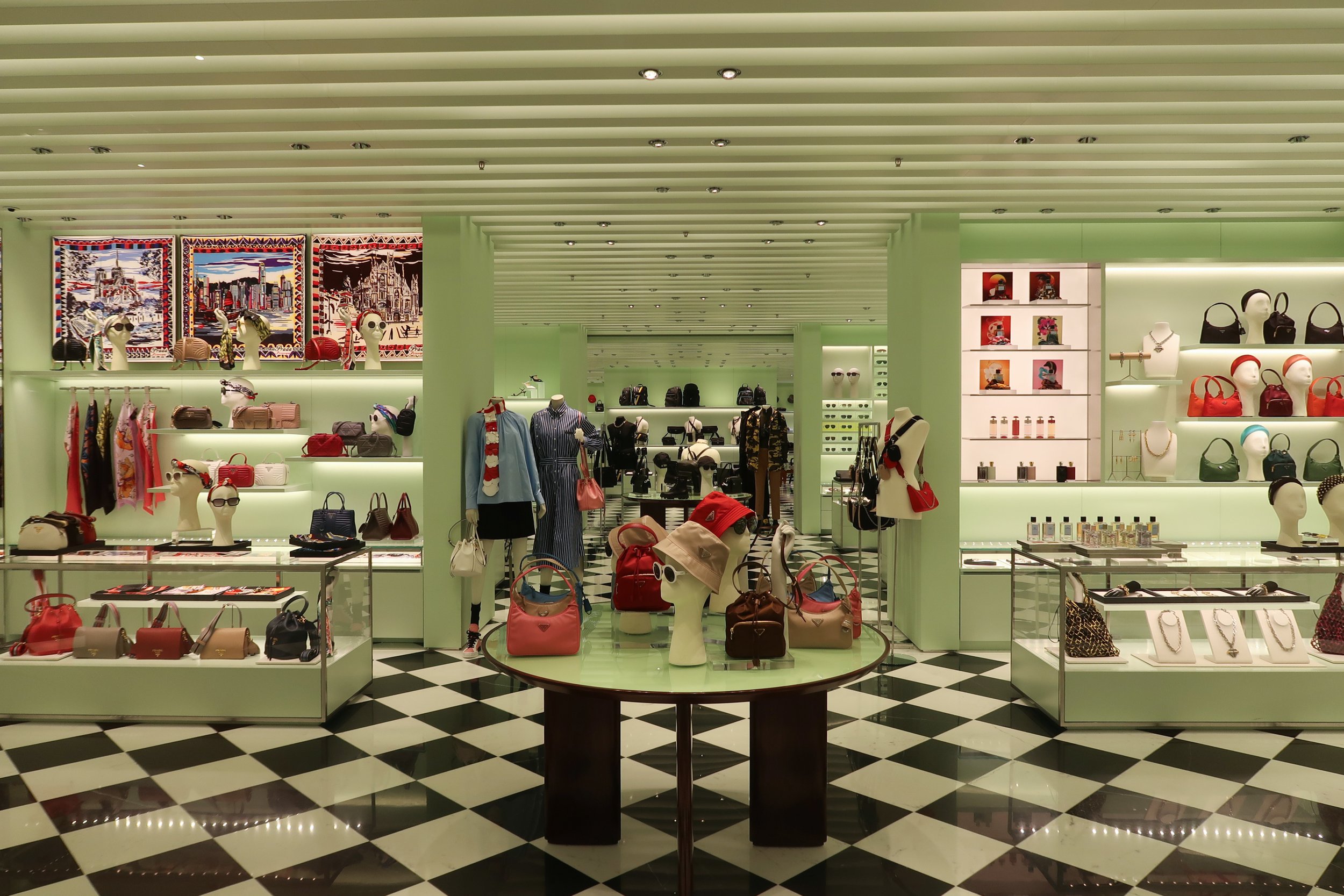Designer Deep Dive: Prada
I’m so excited to bring you another designer history blog post! It’s hard to believe I’ve been doing this series for the last 6 months - it feels like I just started yesterday, but time flies when you’re having fun learning about the history of fashion 😍 Before I started researching Prada I didn’t know much about their history and how they became one of the most renown fashion houses of the world. Whenever I thought of Prada before, their nylon backpack always came to mind, thanks to that infamous Meredith Blake hiking scene from The Parent Trap 😉 (IYKYK). Obviously, there’s so much more to Prada than handbags and nylon, so let’s dive in!
Starting Out
Prada was founded in 1913 by Mario Prada in partnership with his brother, Martino. They opened their first store in the prestigious Galleria Vittorio Emmanuele II in Milan, Italy which sold a variety of leather goods like bags, trunks, and travel accessories. It’s also why every Prada bag features that little metal triangle and its legend “Milano da 1913”. Unlike other prestigious fashion designers that I’ve researched, there honestly isn’t a lot of information available on how Mario got his start in this industry or the events leading up to his first store opening, so I don’t have a lot of backstory to share in that regard. But what we do know is that his bags were remarkable enough to be awarded the title of “Official Supplier of the Italian Royal House” in 1919 - pretty impressive! This recognition allowed Prada to display the House of Savoy coat of arms and knotted rope design in its trademark logo, which contributed to making the brand a benchmark for Italian aristocracy and upper-middle class.
Patriarchy was incredibly prominent during this time and as a result, Mario didn’t think women should work outside of their home. He didn’t include his female family members in his business and his only son ironically had no interest in participating! That all changed though when Mario Prada passed away in 1958 and his daughter, Luisa Prada, took over the family business as his successor and ran it for almost twenty years!
A Fresh Perspective
Things really shook up for Prada in 1975 when Luisa’s daughter, Miuccia Prada, joined the family business. She had tons of fresh ideas and is responsible for creating the brand recognition that we know today! She didn’t always believe that fashion was her calling though. She once explained that although she loved clothes, fashion was “the worst place for a feminist in the ‘60s.” So before she joined her mom at Prada, she got a Ph.D. in political science, studied mime, and also joined the Italian Communist Party. Pretty wild, right?! In 1977 Miuccia married Patrizio Bertelli who was no stranger to the business or fashion world, as he ran a luxury leather company at the time and would join Prada full-time a year later. Patrizio’s involvement in the company really helped to drive the brand forward and expand its product offerings beyond the luggage and steamer trunks they were selling at the time, which included the debut of their first women’s shoe collection in 1979.
Expanding The Brand
In 1983 Prada grew the number of their retail stores which focused on a new design aesthetic featuring a gorgeous shade of light green, which would soon be given the name “Prada Green”. The first “Green Store” opened in Milan and soon was followed by New York, London, Madrid, Paris, and Tokyo. Miuccia’s first creation for the brand in 1984 was the now-iconic Vela backpack that I mentioned at the beginning of the post; it’s instantly recognizable with it’s flat top, buckle closures, and nylon fabric. The backpack was reintroduced in 2019 (still just as popular today) and retails for close to $1,800! You may be asking yourself why a nylon bag costs just as much as a leather one, and during an interview in 2004 Miuccia explained that they were actually more expensive than leather bags because it took several years to work with the nylon and develop the technique. “Back in the 1990s, I found a company that was spinning a very specific type of nylon. It was more expensive than silk because the thread is really thin and very precious” she said. Miuccia clearly knew what she was doing and her success didn’t stop there.
A few years later in 1988 she launched the first women’s ready-to-wear collection which was incredibly well-received by the press, fashion industry, and celebrities alike. The collection featured dropped waistlines and narrow belts, and Prada purposefully didn’t want to have a prominent logo that was seen amongst other designers at the time such as Louis Vuitton. Prada also debuted the younger and slightly less expensive line Miu Miu (Miuccia’s nickname) in 1992. I’m having a mind-blown 🤯 moment right now because I never knew that’s what Miu Miu stood for! Makes me love it even more 😍 One other side note: Last week I saw one of my favorite fashion bloggers, Victoria MacGrath, wearing a stunning Miu Miu dress on a trip to St. Tropez and I absolutely fell in love with it! 🖤 When you see the dress you can truly understand the brand’s attention to detail and the quality of their designs.
The following year Prada launched their first men’s collection in 1993 with the first runway show taking place in Milan. By 1996, Prada had received 2 CFDA () awards (one for accessories and one for “designer of the year”), and they had also opened their largest boutique in Manhattan. At that point they had over 40 boutique locations worldwide! Prada was doing incredibly well, but they wanted more. In the late 90’s, they were determined to have a leading portfolio of high-end luxury brands, similar to LVMH and the Gucci Group. As a result, they purchased Helmut Lang, Jill Sander, and Church & Company (a British shoe manufacturer). In the fall of 1999, Prada joined with LVMH to add yet another well-renowned luxury brand to their portolfio and purchased a 51% stake in Fendi. Prada ended up taking on Fendi's debt as they weren’t profitable at the time, which ultimately led them to sell the other brands they purchased by the mid-2000’s in an attempt to “stop the bleeding”.
A Buzzworthy Art Installation
Maybe you’ve heard of or seen photos of the Prada Maria art installation in the middle of the desert in Valentine, Texas, about 30 miles outside of Marfa. It was created by Scandinavian artists Elmgreen & Dragset in 2005 and designed to mimic a real-life Prada store. They constructed the building out of biodegradable materials with the goal of leaving Prada Marfa completely untouched, slowly watching it decompose into nature and serving as a subtle nod to American consumerism and retail tourism. They even enlisted the help of Muccia who hand-selected $80,000 worth of merchandise from Prada’s 2005 handbag and shoe collection to stock this faux store-front, whose doors would always remain locked. The installation officially debuted on October 1, 2005 and drew more crowds than anticipated thanks to media coverage, but sadly within 5 days, the installation was looted and graffitied. Despite their original intent, the artists returned to repair the building and install security measures in the hopes of deterring further vandalism. They also swapped out the shoes so that only the right foot was on display, the bottoms of the bags were cut out, and stronger glass was installed. The structure remained relatively untouched until another larger-scale vandalism that occurred in March 2014, which resulted in more graffiti and TOMS stickers being placed on the glass. After that incident, Prada Marfa ran into yet another roadblock when the Texas Department of Transportation classified Prada Marfa as an illegal roadside advertising. In order to come to some sort of agreement, the nonprofit that worked with the artists, The Art Production Fund, agreed to donate Prada Marfa as a "civic gift" to the public.
Prada Today
In February of 2020, Prada named Raf Simmons as their co-creative director after previously working at Christian Dior, Calvin Klein, and, Jil Sander (which Prada previously owned) and would be working directly alongside Miuccia. What I admire about their partnership is not only how they push the boundaries of creativity, but they are very mindful in the collections they create. With so much happening in the world, their focus is ensuring that what they produce is meaningful and “ in the service of people.” In a recent interview with Business of Fashion, they also said, “There is this desire from both of us to evolve the brand, not just repeat it.” I’m so excited to see many more collections from this immensely talented, collaborative duo and what the future holds for Prada!





